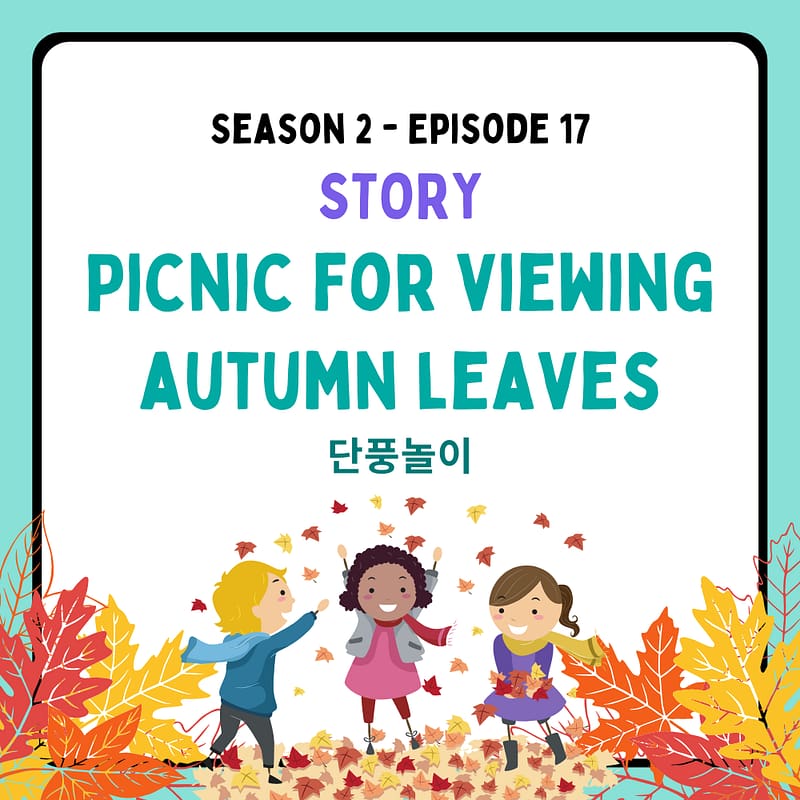Powered by RedCircle
시즌2, 17화. 이야기편 | 단풍놀이
Season 2, Episode 17 – Story | Picnic for viewing autumn leaves
Korean Script
한국은 봄, 여름, 가을, 겨울, 사계절이 있어요. 그 중에서 저는 가을을 가장 좋아해요. 왜냐하면 날씨가 안 덥고 안 추워서 시원하기 때문이에요. 그리고 한국의 가을은 단풍이 들어서 풍경이 정말 예뻐요. 그래서 이번 주말에 가족들이랑 같이 단풍놀이를 갔어요.
우리 가족은 매 가을마다 단풍놀이를 가요. 올해는 지리산으로 갔어요. 등산을 하면서 빨간색, 노란색, 주황색으로 변한 나뭇잎을 구경했어요. 산에 다람쥐도 많고 새도 많았어요. 그래서 알록달록한 산이 더 아름다워 보였어요. 우리 가족은 단풍 구경이 끝나고 점심을 먹으려고 벤치를 찾았어요. 거기에서 맛있는 도시락도 먹고 간식으로 군밤과 감도 먹었어요.
알록달록한 단풍을 보니까 기분이 정말 좋았어요. 우리 가족들과도 행복한 시간을 보낸 것 같아요. 내년에도 또 가고 싶어요.
English Translation
Korea has four distinct seasons: spring, summer, autumn, and winter. Among them, I like autumn the most, because the weather is neither hot nor cold, it is chill.
And in autumn in Korea, the leaves’ color turns, and the scenery is stunning. So this weekend, I went on autumn leaves watching with my family.
Our family goes to autumn leaf-watching every fall. This year we went to Jiri Mountain.
While hiking, we saw the leaves that turned red, yellow, and orange. There were many squirrels and many birds in the mountain. As a result, the colorful mountains looked more beautiful. My family and I found a bench for lunch after viewing the autumn leaves. There, we ate delicious packed lunches and ate chestnuts and persimmons as dessert.
It felt wonderful to see the colorful autumn leaves. I think our family had a joyful time together. I want to go again next year.
How was it? Were you able to understand most of the parts? Even if you didn’t, it’s totally fine because we will see the meaning together now.
All right, then, Now let’s break down some valuable expressions together.
한국은 봄, 여름, 가을, 겨울, 사계절이 있어요. 그 중에서 저는 가을을 가장 좋아해요. 왜냐하면 날씨가 안 덥고 안 추워서 시원하기 때문이에요. 그리고 한국의 가을은 단풍이 들어서 풍경이 정말 예뻐요. 그래서 이번 주말에 가족들이랑 같이 단풍놀이를 갔어요.
In this part, we can hear the sentence structure, including a syllable 서 which connects two sentences smoothly.
This word 서 is from the word 그래서 which means so or that’s why. And use the conjugated verb form and add 서 at the ending part. Let’s see an example in this part together.
왜냐하면 날씨가 안 덥고 안 추워서 시원하기 때문이에요.
It’s because the weather is neither hot nor cold, it’s chill.
Also the other one was
한국의 가을은 단풍이 들어서 풍경이 정말 예뻐요
In autumn in Korea, leaves turn colors, so the sceneries are stunning.
Do you see how we can use this in a sentence? Let’s see more examples with this word in more straightforward sentences.
지민이 너무 잘 생겨서 팬이 많아요. Jimin is too handsome, so he has many fans
김치찌개가 맛있어서 저는 자주 먹어요. Kimchi stew is delicious, so I eat it often
한국 드라마가 재미있어서 저는 한국드라마에 중독되었어요. Korean dramas are entertaining, so I am addicted to them.
All right, now that we know how to use the word 서 to connect two sentences in one sentence, we go on to hear the next part and learn a new expression
우리 가족은 매 가을마다 단풍놀이를 가요. 올해는 지리산으로 갔어요. 등산을 하면서 빨간색, 노란색, 주황색으로 변한 나뭇잎을 구경했어요. 산에 다람쥐도 많고 새도 많았어요
Let’s see this sentence structure in this part.
우리 가족은 매 가을마다 단풍놀이를 가요. My family goes on a picnic to viewing autumn leaves 단풍놀이 every autumn 매 가을마다.
Korean people like to enjoy going on picnics to view the beautiful sceneries that are changed every season.
So we go on a picnic to view the sceneries with cherry blossoms in spring. We call that picnic as 벚꽃놀이, the literal translation of this word is 벚꽃 cherry blossom 놀이 playing, 벚꽃놀이.
And in autumn, we go 단풍놀이 autumn colored leaves 단풍 playing 놀이. 단풍놀이.
Lastly, in winter, we go to 눈구경 snow 눈, watching 구경, 눈구경.
And since many people go on a vacation in summer 여름 휴가, there doesn’t exist a particular type of picnic word for summer.
So again in spring 봄, picnic for viewing cherry blossoms 벚꽃놀이
in autumn 가을, picnic for viewing autumn colored leaves 단풍놀이
in winter 겨울, picnic for watching the snow 눈구경
Do your country also have this kind of culture? Let me know if you have any similar to this. 🙂
Okay, now let’s see a proper sentence structure.
우리 가족은 매 가을마다 단풍놀이를 가요.
매 가을마다 every autumn, each autumn
If you add 마다 after a word related to a time, it means every __ or each ____.
Also, the word 매 means every ____ or each _____.
So you can use them together like this, and also you can often use one of them in a sentence depending on the pairing word
Let’s hear some more examples.
저는 매일 넷플릭스에서 한국 드라마를 봐요 I watch Korean dramas on Netflix every day
BTS는 해마다 콘서트를 해요. BTS has a concert each year
우리 가족은 봄마다 벚꽃놀이를 가요 My family goes to a picnic to view cherry blossoms each spring.
How is it? Do you get how to use this expression?
All right, then now let’s move on and listen to the next part.
그래서 알록달록한 산이 더 아름다워 보였어요. 우리 가족은 단풍 구경이 끝나고 점심을 먹으려고 벤치를 찾았어요. 거기에서 맛있는 도시락도 먹고 간식으로 군밤과 감도 먹었어요.
In this part, let’s break down the sentence structure “우리 가족은 단풍 구경이 끝나고 점심을 먹으려고 벤치를 찾았어요.”
점심을 먹으려고 벤치를 찾았어요 We searched a bench to have lunch
When we want to express doing some action or behavior to do something else, we use “으려고.” Actually, there’s another word for connecting, that’s “으러”
What’s the difference between 으려고 and 으러? That’s pretty simple. That depends on the verb.
If the sentence should be used the verbs 가다 go, 오다 come, 다니다 go regularly, then the connecting part always should be 으러. Otherwise, you can use 으려고 instead of it. 으러 actually can be replaced to 으려고 in many cases, but vice-versa wouldn’t really happen.
Then let’s hear some more examples.
지금 제 친구는 김밥 사러 식당에 갔어요. My friend went to a restaurant to buy Kimbap now
저는 BTS를 보러 한국에 왔어요 I came to Korea to see BTS
저는 가수가 되려고 매일 노래 연습을 해요. I practice singing every day to become a singer
지금 조별 숙제를 하려고 친구들과 같이 회의를 해요. I have a meeting with my friends to do group homework now
Okie Dokie, then now let’s hear the last part.
알록달록한 단풍을 보니까 기분이 정말 좋았어요. 우리 가족들과도 행복한 시간을 보낸 것 같아요. 내년에도 또 가고 싶어요.
In this part, let’s see the sentence structure with 니까, which means so, and that’s why again.
The difference between 서 and 니까 is not much. Meaning-wise, it’s almost the same. Just a different form is paired with a particular type of expression.
In other tenses of sentences, you can use one of these. But you have to use 서 when you want to say everyday words of greeting like 반갑다, 고맙다, 감사하다, 미안하다, 죄송하다, etc.
For example, the greeting expressions always should be like so
만나서 반갑습니다 Nice to meet you
도와줘서 고맙습니다 Thank you for helping me
못 도와줘서 죄송합니다 I’m sorry for not being able to help you.
Also, you should use 니까 when you want to say imperative, or propositive sentences like please do something, or shall we do something? Let’s do something and so on.
배고프니까 빨리 음식 시키세요 I’m hungry so order the food quickly
피곤하니까 내일 더 이야기할까요? I’m tired, so shall we talk more about it tomorrow?
날씨가 좋으니까 같이 소풍가요. The weather is good so let’s go on a picnic together.
Hahaha. It might seem not very easy at first. But if you think about English sentences, for saying the similar meaning, there’s a lot of ways, such as so, that’s why, because, since, as and so on.
So what I’m trying to say is don’t get frustrated too much; this is how a language is supposed to be since a language is like a code that is made based on a compromise that a ton of people made over the years.
Also, try to see as many examples as possible, then you would be able to distinguish which one it sounds more natural with.




